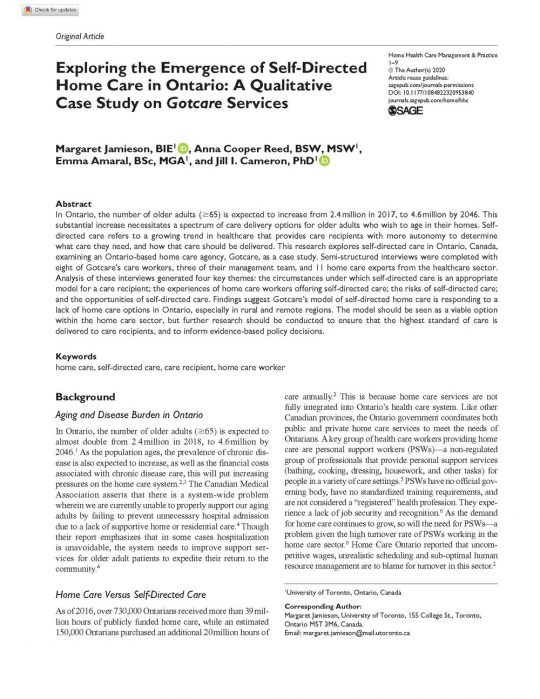Background
Canada faces a shortage of home care options that will intensify as the proportion of older adults in the country continues to increase—especially in rural and remote regions. 1 . 2
Programs and services to support older adults in their homes and communities are cost effective and lead to positive health outcomes. Home care in Ontario is estimated to cost approximately $45 per day, compared to care costs of $135 per day in a long-term care facility and $450 per day in a hospital.3 4
Despite its cost-effective positive outcomes, home care is not included under the Canada Health Act and remains difficult to access for many Ontarians. Publicly funded home care services are managed by the provinces and territories as well as several federal departments and agencies (e.g., Veterans Affairs Canada and Indigenous Services Canada).5 6 7
Home care can also be purchased through private insurance, employee benefit plans, or out of pocket. In 2016, over 730,000 Ontarians received more than 39 million hours of publicly funded home care, while an estimated 150,000 Ontarians are forced to purchase an additional 20 million hours of care annually.8 Furthermore, Ontario cut acute-care hospital beds by 44 percent between 1990 and 2014, and has fewer hospital beds per capita than any other Canadian province or territory.9 10
Stakeholders do not agree on solutions to address the home care sector’s shortcomings, despite the continuing increase in demand from the province’s aging population. In 2017 the Ontario government formed the Self-Directed Personal Support Services Ontario (SDPSSO) agency to directly employ a pool of Personal Support Workers (PSWs) and manage their pay and training while enabling care recipients to choose their care provider and schedule their own services.11 The SDPSSO’s implementation was halted by a coalition of home care service providers (a group of eleven nonprofit and for-profit organizations who in total provide 95 percent of home care services in Ontario)12 4 After a change in provincial government in 2018, the SDPSSO was dissolved and a new FamilyManaged Home Care program was introduced, which excludes older adults from its eligibility criteria.13
These issues illustrate how fragmented home care is in Ontario. The lack of consensus on how the province’s home care should be organized has led to a patchwork situation where PSWs are at the mercy of different home care companies— with no consistency and no guaranteed quality of employment.
A problematic outcome arising from a lack of consistency in the coordination and delivery of home care in Ontario (including the creation and dissolution of provincial agencies and the vast decrease in the number of LHINs) is the chronic shortage of PSWs. According to the Ontario Ministry of Health and Long-Term Care, the turnover rate among PSWs reached 60 percent in 2014,14 15
PSWs have no official governing body and are not considered a “registered” health profession, and therefore lack both job security and recognition— their employment conditions vary with each contract. 16 4 17 According to Home Care Ontario, uncompetitive wages, inadequate human resource strategies, and unrealistic scheduling and time allocations to provide quality care must be addressed in the home care sector.18 .” 19 20 However, self directed care can also be understood more broadly: according to the Alzheimers Association, “self-directed care services, often referred to as consumer-directed services, is a philosophy and practice that assumes that caregivers have the right and ability to assess their own needs, determine how and by whom those needs are met, and evaluate the quality of the services they receive.”21
Gotcare
Gotcare, established in 2018, is the largest privately operated, self-directed home care provider in Ontario,22 23
Gotcare suggests they are improving career opportunities for home care workers because they can minimize commute times (made possible by location-based matching with care recipients) and offer working hours throughout the day, rather than the traditional home care model of “split shifts” . 24 4
Policy Considerations for Self-Directed Home Care in Ontario
Self-directed home care is on the rise in Ontario. Providers such as Gotcare offer care recipients increased control over their care through the use of digital applications. Although private, these providers can be publicly funded (Gotcare receives a small minority of referrals from LHINs). This model of home care presents many opportunities to a sector in need of innovation, but also risks that should be carefully considered and mitigated by policymakers. (See Annexes 1 and 2 for considerations for both self-directed home care recipients and care workers.) What follows are some of the issues we identified in our case study.
Universality
Home care is not included under the Canada Health Act. Publicly funded home care services vary across jurisdictions when it comes to eligibility, types and amounts of services provided, and whether recipients need to pay for a portion of their care.5 A 2015–16 Canadian Community Health Survey found that over one-third of adults over eighteen years of age with home care needs did not have these needs met, with lack of availability of services as the most frequently reported barrier to obtaining home care.4
Gaps in research and health policy
There are currently no accreditation standards or regulations governing self-directed home care despite the fact that home care recipients are generally a vulnerable population. Research is needed on health and well-being outcomes for care recipients who have received self-directed home care. Guidelines must be developed to ensure high-quality care.
Standards or regulations governing self directed home care should account for various types of cases. For example, Gotcare serves care recipients with severe injuries who are receiving care from PSWs or nurses, as well as those seeking companionship or home-making services who are receiving care from neighbours or family members registered as Gotcare employees. Different use cases are associated with different levels of risk—a key factor for consideration when establishing standards or regulations.
Any new standards or regulations should include corresponding plans for oversight by an independent party to ensure they are being mplemented by home care companies. This oversight should be routinely conducted and transparent to home care recipients.
Policy-makers should clearly delineate and communicate the responsibilities of home care companies, care recipients, and care workers. Each party should be provided with the tools they require to meet their responsibilities. For example, if care recipients and their families are expected to vet care workers’ qualifications, references, and police checks, they must be given appropriate training and support to do so. An absence of rigorous vetting has been an issue in the past. In 2011 the province of Ontario contracted the establishment of a provincial registry of PSWs. This registry was discontinued in 2013 in part because it lacked sufficient vetting of PSWs—numerous PSWs listed in the registry had criminal records or poor employment histories that they did not disclose.17
Policy-makers must produce neutral and reliable information that is readily available to potential home care recipients in Ontario. There is currently a lack of neutral and reliable information, which is particularly important to assist care recipients in making an informed decision between self-directed care or more traditional home care (assuming both are available).
Quality of employment
Gotcare’s self-directed care model provides flexible part-time work for care workers. While this may be ideal for some, it does not provide the full-time hours or job security that is currently missing from the home care sector. However, the company claims its use of technology creates a “lean” operational structure that enables them to pay their care workers above the market average. As the home care sector faces a shortage of care workers, policy-makers should ensure that care workers are paid a competitive wage, have job security, and have the option of full-time work, should they require it. 25 26
Technological considerations
Gotcare requires care recipients and workers to use their digital application and provide data 27
Continuity of care
Many older adults seeking home care have complex needs arising from comorbidities. They may require that their care be coordinated among various healthcare professionals, across hospitals, clinics, etc. Gotcare’s infrastructure currently does not facilitate communication or the regular sharing of updated information between care recipients’ “circle of care.” This issue is not specific to Gotcare—Home Care Ontario has also reported on this lack of coordination despite the potential of digital technology and electronic health records. Frontline home care workers are unable to access or contribute to patients’ health records because “patient information is currently contained in islands of data that reside mostly within the walls of each health care provider. “28 4
Conclusion
Canada’s universal healthcare system, and its core value of high-quality health care for all regardless of a person’s ability to pay, is arguably foundational to Canadian identity. The provision of health care in Canada is dominated by the public sector rather than the private sector. Some stakeholders such as Gotcare argue that this centralized approach has resulted in a lack of innovation, especially in sectors such as home care that typically do not prioritize choice or personalization of care. It is apparent that publicly funded home care is currently insufficient to meet the needs of the aging population in Ontario. Those in need of home care will continue having to top up or otherwise privately purchase home care from nonprofit and for-profit providers for the foreseeable future. If companies such as Gotcare can offer innovative services that increase the availability of home care for recipients, this may provide some relief to an overburdened home care sector.
It is important that policy-makers conduct a thorough analysis of how to modernize the home care sector without compromising the safety of Canadians and the quality of their care. Ensuring that home care is a viable career option for care workers must also be prioritized, in terms of providing job training, job security, and fair compensation. The sector will also have to carefully consider reliable processes to screen care workers before they go into vulnerable peoples’ homes. Modernizing the sector will no doubt involve technology as a powerful tool in creating efficiencies, such as reducing care workers’ commute times and allowing care recipients to coordinate directly with their care workers. There should also be safeguards in place to ensure that recipients who choose self-directed care are doing so after considering options that provide more oversight. And of course, potential care recipients must have the cognitive capacity to take on the responsibilities associated with managing selfdirected care.
Allowing home care to be provided by employees with a broader range of qualifications, from neighbours to nurses and personal support workers, may indeed be an effective way to address the shortage of PSWs. However, if this broadening of the home care sector is not managed in a way that ensures care workers are able to safely care for recipients’ specific needs, vulnerable Ontarians will be at risk. Care recipients experiencing negative outcomes caused by insufficient oversight from home care company management, or the Ministry of Health and Long-Term Care more broadly, could result in a loss of public trust in the self-directed home care model. It is important that policy-makers, home care companies, and other stakeholders such as patient advocacy groups proactively and transparently work together to ensure that risks to care recipients and care workers are lowered to an acceptable level.
Self-directed care could become a core fixture in the healthcare sector. Through the use of technology, Ontarians can now control when they receive care, from whom, and in what way. We found that different participant groups (namely Gotcare management and home care experts) have different interpretations of how to balance providing greater choice, control, and responsibility to care recipients while ensuring that oversight and safety protocols are in place. Policy-makers will need to conduct their own assessments of self-directed home care. Decisions surrounding standards or regulations should be based on empirical evidence which is currently insufficient. In the meantime, companies like Gotcare will continue to fill a gap in the home care sector and provide much-needed home care to Ontarians, who in some cases have no other options.
Annexes 1 and 2: Checklists for Determining Appropriateness of Self-Directed Care
The following checklists were developed based on findings from our case study. The first checklist is intended to be a guide for healthcare professionals responsible for connecting patients with home care services, as well as care recipients and their families, to determine suitability for self-directed care. The second checklist is intended for home care workers who are considering employment with a self-directed home care company, where the nature of service provision differs from more traditional home care companies. While these checklists can be used to support the development of best practices in initiating self-directed home care, given the emerging nature of this care model they should be updated as future research is conducted.
Acknowledgments
This research was made possible through the Reach Alliance, a partnership between the University of Toronto’s Munk School of Global Affairs & Public Policy and the Mastercard Center for Inclusive Growth . We would like to acknowledge the incredible support we received from both Marin MacLeod and Professor Joseph Wong. Finally, we would like to thank Nida Shahid for her early contributions to our study design.
This research was vetted and received approval from the Ethics Review Board at the University of Toronto.
MASTERCARD CENTER FOR INCLUSIVE GROWTH
The Center for Inclusive Growth advances equitable and sustainable economic growth and financial inclusion around the world. The Center leverages the company’s core assets and competencies, including data insights, expertise, and technology, while administering the philanthropic Mastercard Impact Fund, to produce independent research, scale global programs, and empower a community of thinkers, leaders, and doers on the front lines of inclusive growth.
MUNK SCHOOL OF GLOBAL AFFAIRS & PUBLIC POLICY
The Munk School of Global Affairs & Public Policy at the University of Toronto brings together passionate researchers, experts, and students to address the needs of a rapidly changing world. Through innovative teaching, collaborative research, and robust public dialogue and debate, we are shaping the next generation of leaders to tackle our most pressing global and domestic challenges.












